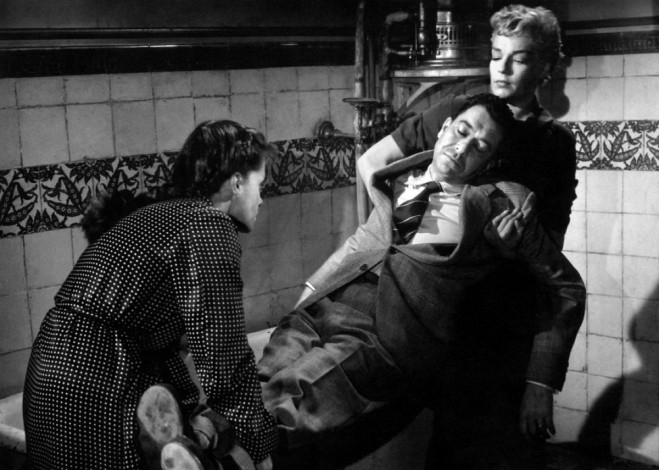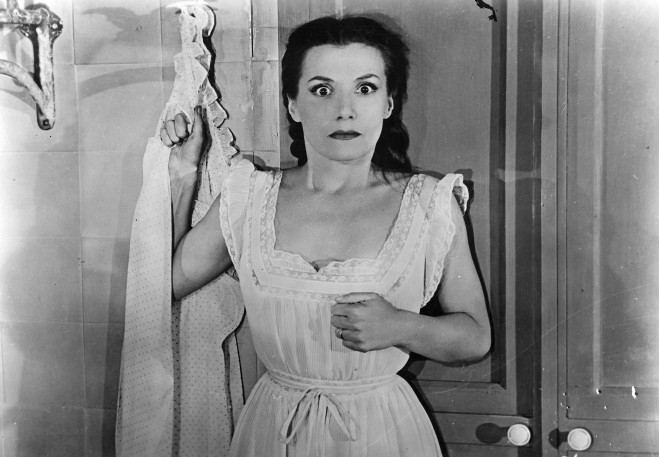
I don’t know what it says about the state of horror movies abroad during the ’30s and ’40s that there wasn’t a single one worth writing about in between the 24-year gap between our last entry and 1955’s Les Diaboliques (though I’m sure there were a few movies made during this period that have already been reviewed in a previous year’s Shocktober). But I’m just gonna go out on a limb (since my non-horror expertise can’t speak for itself) and say that the late ’50s/early ’60s saw a bit of a resurgence in the horror genre due to the Hammer Studios and William Castles of the world, as well the massive popularity of Alfred Hitchcock’s Psycho. Les Diaboliques, helmed by the director Henry-Georges Clouzot, who was often referred to as “The French Hitchcock”, certainly helped established this reputation, but Cluzout also supposedly was able to make the film because he snatched up the rights to the book it was based off of mere hours before Hitch was able to. And then in some weird series of inspiration, the film was so effective in it’s own Hitchcock-ian inclinations that it helped influence Robert Block, the author of Psycho, who claimed that Les Diaboliques was his favorite film of all time. It sort of reminds me of how Brian Wilson was trying to outdo Rubber Soul when he wrote Pet Sounds, which in turn inspired The Beatles to record Sgt. Pepper. But, you know, with more murder.
This murder that Les Diaboliques entails is that of a slimey boarding school headmaster, Michel (played by Paul Meurisse), which has been plotted by Michel’s wife, Christina (Vera Clouzot) and Michel’s mistress, Nicole (Simone Signoret). It certainly says something about the French-ness of this movie that all the other adults that work at this boarding school are well aware of Michel having a mistress, and everyone’s pretty much fine with it, to the extent that the wife and mistress are basically best buds with each other. Anyways, because both of them are fed up with Michel’s douch-ey ways, they take him on a vacation where they drug him and drown him in a bathtub. They then bring his body back to the boarding school to throw the body in the school’s pool, and thus conceal his murder as some kind of accident. However, the pool is drained shortly after the body-dumping, yet the body is no where to be seen, and in the coming days, mysterious instances of Michel being spotted around the boarding school start to ensue.
I know this is gonna sound a little inside baseball, but I did after all go to film school and got a bachelor’s in screenwriting, so I’ll just say I find it interesting that everything I just described plot-wise takes up about half of the movie. I find it interesting because it seems pretty indicative of how movies were constructed story-wise in the ’50s, as nowadays the murder would probably happen about 1/4 into the movie, while the rest of the movie would probably involve lots of underwhelming scares of Michel’s ghost/corpse/whatever showing up and scaring the little shits running around the boarding school. Instead, what we get is an act one that technically takes up half the movie, but in turn ramps up the tension as Christina and Nicole must meticulously try to pull off this murder plot that they are not entirely prepared to execute.
First of all, having seen this movie once before, I forgot how perfect both Vera Clouzot (Henry-Georges Clouzot’s wife, if you hadn’t guessed) and Simone Signoret are in these roles as a put-upon wife that exudes brittleness and a tough broad that’s up to no good, respectively. However, another thing I forgot about this movie is that the second half (which is supposed to be the “scarier” part of the movie), kind of drags a bit. I don’t know if it has to do with the movie’s structure, and how it focuses so much on the conception of this murder (rather than its repurcussions), or if it has to do with the fact that Clouzot maybe doesn’t do enough to milk the eerier elements of Michel’s disappearance and subsequent reappearance as this unidentifiable force throughout the boarding school. But whatever it is, it says something that most of what I remembered of this movie consisted of the beginning, and then the film’s somewhat iconic ending. Also, it should be said that Les Diaboliques was influential in several aesthetic ways, but also just in its recognition that places that have lots of young children around are always great backdrops for spooky shit to go down.
Getting back to the ending, even though I’m not typically a fan of twist endings, I will say that the one that caps off Les Diaboliques not only totally works for me, but I think helps elevate whatever misgivings the movie’s second half might have. I don’t want to spoil anything for those who haven’t seen it (even though, yes, I realize this movie is probably older than your parents). But it involves one of the more unsettling images that I can recall in all of thriller/horrordom, so much so that the movie’s final scene was ranked #49 on John’s beloved 100 Scariest Movie Moments which aired on Bravo. But most of all, it’ll make it so you’ll never look at bathtubs the same way again, even if you’re smart enough to realize that sitting in a pool of your own filth is no way to get clean.


